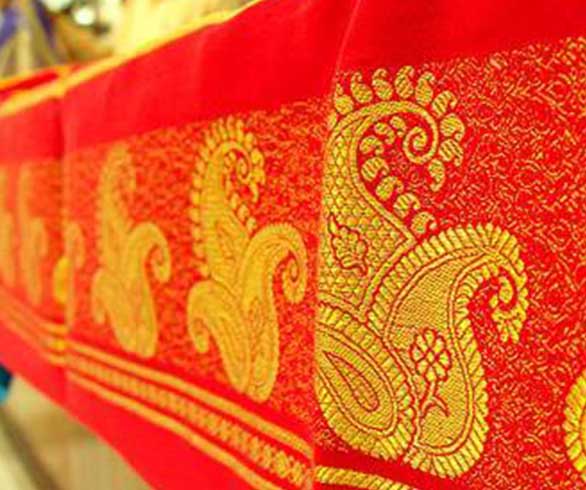Mysore Silk – woven in history, the beauty of a Mysore Silk Saree!

Mysore Silk is a house-hold name not just in Karnataka but across the globe . Call it a part of tradition , or just the beauty of a Mysore Silk saree it has become an important element of most Indian wardrobes. The Mysore Silk in comparison to the other varieties of silks produced in India and elsewhere is known for its fine texture and weaving. The Mysore Crepe Silk is a category which for centuries been popular. Visitors to the southern towns of Mysore ,ensure that they buy , mysore silk . Historical evidence suggests it was Tipu Sultan , who brought Silk to Karnataka . The lion of Mysore saw in the silkworms , a potential to generate income for the people. Records and inscriptions available highlight the keen interest and determination he had for the development of silk industry.As per government records it was the seeds from China that Tipu had specially imported in 1785 that became the parent of the pure Mysore race. Even today, the mulberry variety he had introduced is known as Sultani Kaddi .
The silk industry was further developed by him in Mysore by obtaining silk worms from Bengal and Muscat, and encouraging the plantation of mulberry trees.
Government records throw up documents where Tipu Sultan said ,“I have given detailed instructions for the establishment of silk industry in Mysore. Silkworms and men well-versed in the art of rearing them have already arrived from foreign lands to train our people Every kind of encouragement is being given to plantation of mulberry trees. I would like you to take direct interest in this developmental activity. I want Mysore to be the foremost amongst silk producing nations.”
He set up eighteen centres for development of the silk industry , most of them have grown to become big hubs of silk rearing , weaving and sale.
For over 200 years later , Karnataka has been reaping the rewards of the efforts put in by Tipu and his men. Even today Karnataka accounts for nearly 9000 MT’s or over 70% of the approximately 14,000 MT’s of mulberry silk produced in India. In recent years however Mysore Silk industry has been facing challenges. The cheaper imports of Silk from China have shrunk revenues over the last few decades, making it unviable for many to continue in the silk-trade.
While the farmers who reared silk-worms to supplement family income were hit , the traditional weavers have been losing work due to dropped production of silk-bolls.
A massive intervention program by the Karnataka government is now finally offering hope to those linked with the Silk business. By taking a bold step , the Karnataka government’s Horticulture minister under the Mahatma Gandhi National Rural Employment Generation Act ( MNREGA). Under the scheme, the silk-worm rearing has got a new thrust as farmers’ families sitting in the backyard of their houses can rear silk which will help supplement farm income. A Manju , minister of Horticulture speaking to Policy Pulse said, ”The farmers are once again seeing lucrative returns. Especially that we have suffered drought in last five years in many regions and silk rearing assures them a return of a minimum 1 lac per acre. Silk industry is getting all the support.”
The onslaught by Chinese varieties of cheaper Silks has been responsible for killing the enterprise of the farmers. The customs duties on silk yarn import which was 30% earlier was reduced to 10% after Narendra Modi government came to power made Indian ,especially Mysore silk trade unviable. A Manju, Minister for Horticulture and Sericulture told Policy Pulse,” I have written to the Prime Minister on many occasions to not just take the duty up to 30% , but also to impose a Counter veiling Duty (CVD) to Chinese imports. Only such steps will help the Mysore silk become a part of the Make In India initiatives once again. Its critical to sustain the weaving activity as millions of people are involved”.
The Karnataka government’s sericulture department has in the last two years taken up financing the weavers to the tune of Rs 3 lacs each to help them buy and stock raw silk cocoons. Moves like this have helped them go back to weaving which was not viable and seemed like a challenge some years ago. The moves have started bringing results as weavers are now able to get a better return. While some of these moves have been productive , some others are still in the process of implementation and may make a while before the glory of Mysore Silk can be revived.
The changing lifestyles and rising use of western-wear in the younger generations has been shrinking the domestic markets and consumptions. The marketing arm of the Karnataka Government’s sericulture , Karnataka Silk Industries Corporation is now focusing on reverse integration of skills. A Manju said, “The officials of KSIC which sells the silk and sarees it procures from weavers cooperatives is educating them on fashion trends and developing newer product ranges. This year KSIC could share a dividend of Rs 22 cr. to the Government offers hope that we are on the right track. We want to take Mysore Silk international and are working on it in a big way ”
KSIC which made a pitch for Air-India hostesses to drape Mysore silk as part of uniform two years ago, is now roping in fashion designers and celebrities to promote the brand internationally. Apart from shrugging its government lethargy , revamping its online operations, the government’s retail arm is developing its ground presence in major metro cities.
Another challenge that the government and industry is facing is the counterfeit qualities which get passed off as original. Especially in the areas of the Gold Borders which adorn the sarees , the customers always fear being shortchanged. The big concern of fake silk which worries many customers is also being addressed in a big way by the government. Certification processes of “Silk-Mark” which were mere formalities till some years ago are being shored up to build the trust by putting in proper certification processes. “We agree that re-building the brand to its old glory is a big challenge. We have set up new Quality control centres, sacked over 70 people involved in fake certification. The mission is clear to build sericulture as a viable source of income to support farmers” says A Manjunath , Minister for sericulture.
While the steps maybe aimed in the right direction , the challenge is to bring back sericulture and mulberry plantations to the targeted 65000 acres from the 34,000 acres it had dwindled to. While the efforts have shored up acreage , it may be a while before the Mysore Silk regains its past glory.






0 Comments